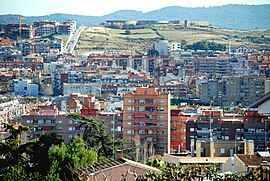Canovelles
| Canovelles | |||
|---|---|---|---|
| Municipality | |||

Buildings seen from the street of Sant Eudald of Canovelles
|
|||
|
|||
| Location in Catalonia | |||
| Coordinates: 41°37′13″N 2°17′5″E / 41.62028°N 2.28472°ECoordinates: 41°37′13″N 2°17′5″E / 41.62028°N 2.28472°E | |||
| Country |
|
||
| Autonomous community |
|
||
| Province | Barcelona | ||
| Comarca | Vallès Oriental | ||
| Government | |||
| • Mayor | José Orive Vélez (2015) | ||
| Area | |||
| • Total | 6.7 km2 (2.6 sq mi) | ||
| Elevation | 175 m (574 ft) | ||
| Population (2014) | |||
| • Total | 15,954 | ||
| • Density | 2,400/km2 (6,200/sq mi) | ||
| • Demonym | Canovellí, canovellina | ||
| Website | www |
||
Canovelles (Catalan pronunciation: [kənuˈβeʎəs]) is a municipality situated in the comarca of Vallès Oriental, in the province of Barcelona, part of the autonomous community of Catalonia in northeastern Spain. It is located about 2 km (1.2 mi) from the local capital of Granollers, with which it forms a conurbation.
The vast majority of the immigrants of the last decade and their descendants live in the Barriada Nova (New Quarters). However, the members of the immigrant wave in the 1960s and 1970s are gradually moving further into the peripheral districts. Public housing shortages and the high price of private housing are driving young people out of the area, and into municipalities in the same region.
During the 1950s and 1960s, Canovelles saw a dramatic increase and immigration from other parts of Spain – namely from the nearby region of Barcelona. Because of this explosion in population, much of Canovelles’ economy stems from the service sector.
Another major source of regional economy comes from the weekly market held every Sunday, comprised by more than 500 shops. This market focus on the distribution of clothing, electronic devices and fruit.
Numerous archeological finds from the Neolithic Period and the Roman Empire have been found in Canovelles. One representative is the “Menhir”, a replica of which is displayed at the Can Palots Theater exhibition hall.
The first time the term Canovelles appears in a document is in 1008 AD, in a document pertaining to the Abbot of Sant Cugat.
Between the 1950s and the 1970s, many families from Extremadura and Andalusia arrived to the municipality, increasing the population by a factor of twenty. Since the end of the 1990s people from Morocco, Sub-Saharan Africa, and Latin America have been arriving to Canovelles in great numbers.
...
Wikipedia



